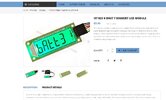Fluffyboii
Active Member
In this post you can see me struggle with driving Static drive LCDs with MUX mode. MUX drive mode creates segments that partially lit up when they should be off. So my only option is direct driving the 7 segment LCDs. PIC16F1939 can only drive 24 segments on Static mode. Which means it can only drive 3 digits. I was thinking of possible ways to tackle this problem but the cheapest and easiest way to do this seems to be using a PIC16F1936 as a slave to drive 2 digits itself and driving other 2 digits with the PIC16F1939 or just using two PIC16F1936s. Since I already have a PIC16F1936 and 1939 in SMD package first option is fine by me. I can design a simple PCB to solder the LCDs and microcontrollers on.
I know it is extremely wastefull in terms of processing power to use another MCU to drive 2 digits woth of LCD displays to make a dumb clock but this is possibly the cheapest and easiest option since I already have the PICs and I do not want to buy another PIC or PICkit.
So what is the most optimal way to comminucate between the MCUs? Should I look into Serial communication or I2C? Or should I just use digital pins to send binary data directly to the second PIC? Since the only purpose of the second PIC will be displaying numbers and maybe letters it should not need a fancy communication protocol and 5 digital pins should be enough to send whatever I want displayed in binary. Could possibly use the DAC and ADC in these PICs to send analog voltages that equal to whatever I want displayed I guess but sounds like a big hassle to program. The use of two MCUs to drive LCDs is probably a unnecessary bid hassle anyway, I guess.
Since the whole project of making a dumb clock got out of hand in terms of costs and efford involved I am okay with wasting even more resources and time into it. If I can use the second slave PIC for something else than just driving the LCDs, for example getting button inputs etc. I will be able to justify using two microcontrollers. The whole thing is a solution looking for a problem to solve.
I know it is extremely wastefull in terms of processing power to use another MCU to drive 2 digits woth of LCD displays to make a dumb clock but this is possibly the cheapest and easiest option since I already have the PICs and I do not want to buy another PIC or PICkit.
So what is the most optimal way to comminucate between the MCUs? Should I look into Serial communication or I2C? Or should I just use digital pins to send binary data directly to the second PIC? Since the only purpose of the second PIC will be displaying numbers and maybe letters it should not need a fancy communication protocol and 5 digital pins should be enough to send whatever I want displayed in binary. Could possibly use the DAC and ADC in these PICs to send analog voltages that equal to whatever I want displayed I guess but sounds like a big hassle to program. The use of two MCUs to drive LCDs is probably a unnecessary bid hassle anyway, I guess.
Since the whole project of making a dumb clock got out of hand in terms of costs and efford involved I am okay with wasting even more resources and time into it. If I can use the second slave PIC for something else than just driving the LCDs, for example getting button inputs etc. I will be able to justify using two microcontrollers. The whole thing is a solution looking for a problem to solve.

